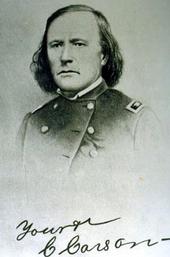Kit Carson
Enshrined in popular mythology even in his own lifetime, Kit Carson was a trapper, scout, Indian agent, soldier and authentic legend of the West.
Born on Christmas eve in 1809, Carson spent most of his early childhood in Boone's Lick, Missouri. His father died when he was only nine years old, and the need to work prevented Kit from receiving an education. He was apprenticed to a saddle-maker at fourteen. At sixteen, Carson secretly signed on with a large merchant caravan heading to Santa Fe tending the horses, mules, and oxen.
In 1826-1827, Carson wintered in Taos, New Mexico with Matthew Kinkead, a trapper and explorer who had been a friend of his father in Missouri. Taos was known as the capital of the fur trade in the Southwest, and Kit began learning the skills of a trapper from Kinkead. Additionally he learned languages and became fluent in Spanish, Navajo, Apache, Cheyenne, Arapaho, Paiute, Shoshone, and Ute.
After gaining experience along the Santa Fe Trail and in Mexico on various expeditions, Carson signed on with Ewing Young and forty other fur men in the Spring of 1829, his first official outing as a trapper. The journey took the band into unexplored Apache country along the Gila River. Ewing's group was approached and attacked by Apache Indians. It was during this encounter that Carson shot and killed one of the attacking Indians, the first time circumstances required him to act in a way that resulted in another's death.
At the annual mountain man rendezvous during the summer of 1835 . Carson was involved in a dispute over an Arapahoe woman named Singing Grass (Waa-ni-beh). Both Carson and the French-Canadian trapper, Joseph Chouinard pursued her, but she chose Carson over Chouinard. The stilted Chouinard became belligerent, until the usually mild Carson could tolerate the situation no longer. After words were exchanged, Carson and Chouinard charged each other on horses with drawn pistols: Carson blew off the thumb of his opponent, while Chouinard's shot missed. This incident is said to have made Carson renowned among the mountain men, but was considered to be uncharacteristic conduct for him.
Carson considered his years as a trapper to be "the happiest days of my life". Accompanied by Singing Grass, he worked with the Hudson Bay Company, as well as the renowned frontiersman Jim Bridger, trapping beaver along the Yellowstone, Powder, and Big Horn Rivers, and was found throughout what is now Colorado, Utah, Wyoming, Idaho, and Montana.
When the fur trade began to soften around 1840, Carson became a hunter for William Bent at Bent's Fort. Then in the summer of 1842, Carson happened to meet John C. Fremont, who soon hired him as a guide. Over the next several years, Carson helped guide Fremont to Oregon and California, and through much of the Central Rocky Mountains and the Great Basin. His service with Fremont, celebrated in Fremont's widely-read reports of his expeditions, quickly made Kit Carson a national hero, presented in popular fiction as a rugged mountain man capable of superhuman feats.
Carson's notoriety grew as his name became associated with several key events in the United States' westward expansion. He was still serving as Fremont's guide when Fremont joined California's short-lived Bear-Flag rebellion just before the outbreak of the Mexican-American War in 1846, and it was Carson who led the forces of U.S. General Stephen Kearney from New Mexico into California when a Californio band led by Andrés Pico mounted a challenge to American occupation of Los Angeles later that year.
At the end of the war, Carson returned to New Mexico and took up ranching. By 1853, he and his partner were able to drive a large flock of sheep to California, where gold rush prices paid them a handsome profit. This same year Carson was appointed federal Indian agent for Northern New Mexico, a post he held until the Civil War imposed new duties on him in 1861.
Carson played a prominent and memorable role in the Civil War in New Mexico. He helped organize the New Mexico volunteer infantry, which saw action at Valverde in 1862. Most of his military actions, however, were directed against the Navajo Indians, many of whom had refused to be confined upon a distant reservation set up by the government. Beginning in 1863 Carson waged a brutal economic war against the Navajo, marching through the heart of their territory to destroy their crops, orchards and livestock. When Utes, Pueblos, Hopis and Zunis, who for centuries had been prey to Navajo raiders, took advantage of their traditional enemy's weakness by following the Americans onto the warpath, the Navajo were unable to defend themselves. In 1864 most surrendered to Carson, who forced nearly 8,000 Navajo men, women and children to take what came to be called the "Long Walk" of 300 miles from Arizona to Fort Sumner, New Mexico, where they remained in disease-ridden confinement until 1868.
After the Civil War, Carson moved to Colorado in the hope of expanding his ranching business. He died there in 1868, and the following year his remains were moved to a small cemetery near his old home in Taos.
Try the BEST MySpace Editor and MySpace Backgrounds at MySpace Toolbox !
